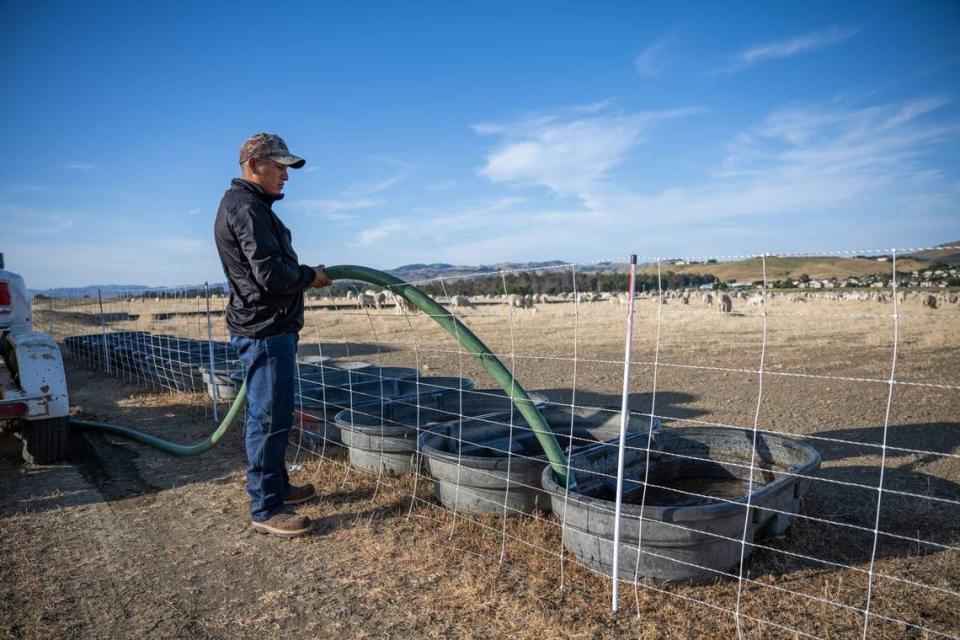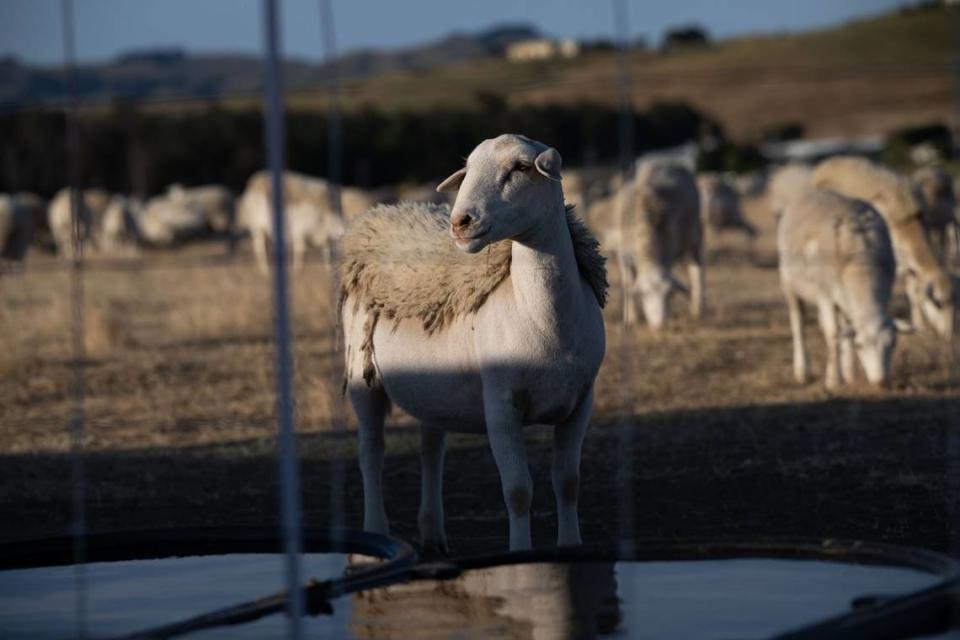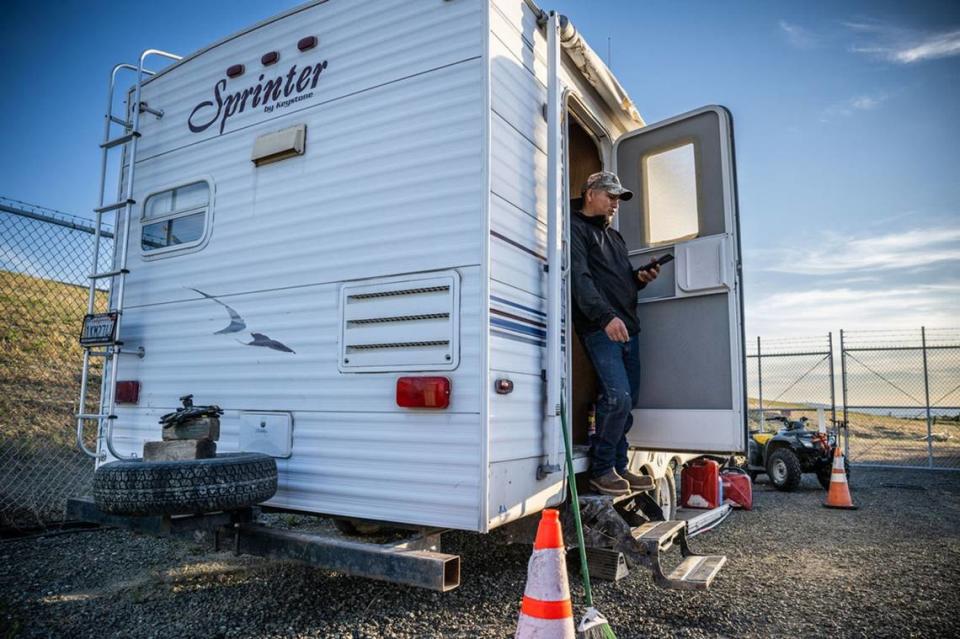Goat herders prevent California wildfires. Most haven’t seen their families in years
What's a fair wage for immigrant goat herders?
Sudden minimum wage changes have left the targeted grazing industry reeling, but advocates say that scrutiny was long overdue. Here's what you need to know.
Demand for goat grazing to reduce wildfire fuel has grown in recent years. Goats can clear brush in rough terrain where hand crews or machinery are impractical, and near buildings where prescribed burning is too dangerous.
Americans don't want to work as herders, who live in trailers on-site and must be ready for disruptions 24/7, so operators hire temporary Peruvian workers on H-2A visas to come for three years at a time. Exempt from the hourly minimum wage, they are currently paid around $4,000 per month.
A "bureaucratic error" by the state may quadruple wages to $191k per year overnight. After a coalition of operators hired a lobbyist, lawmakers will likely pass legislation preventing the increase.
In the long term, advocates and operators both say that the minimum wage exceptions and restrictive immigrant visas need a permanent replacement, for the workers' and industry's sake.
Luis Yauri Oyola hopes one day to buy a tractor to start a business in Peru. He currently works on job sites around California as a goat and sheep herder, making around $4,000 per month; he estimates that he is six years away from having enough for the tractor.
But the only way Oyola can make that amount of money — more than a congressman in Peru, he said — is by spending more than a decade of his life living thousands of miles away from his family, returning home only once every three years for 90 days before resuming work. While in California, Oyola is on call 24/7 and doesn’t leave the job site except for necessities. On a temporary agricultural visa specific to the job, he and his family have no realistic path to permanent residency or citizenship.
Christmas Eve and Christmas are the hardest days.
“The only thing that keeps me going is the phone and talking to my children,” he said in Spanish. (All of his quotes were translated for this story.)
Once a niche solution, demand for targeted livestock grazing in California — an industry dependent mostly on Peruvian herders like Oyola, who come on H-2A visas limited to jobs U.S. workers don’t want to do — has grown in popularity as fire agencies sought more comprehensive wildfire prevention solutions.
In 2021, the California Department of Forestry and Fire Protection awarded more than $10 million in wildfire prevention grants for projects involving targeted grazing, public documents show. A Cal Fire spokesperson credited one grazing project with helping stop the 16,970-acre Alisal fire in Santa Barbara that year.
Ramifications from a March 2022 “bureaucratic error” threaten to quadruple labor costs for goat grazers overnight, leading operators to sound the alarm that the industry — and California’s wildfire mitigation — is at risk. These need to be addressed with legislation cementing herders’ exception from the hourly minimum wage, operators say.
But labor advocates said that if the industry is increasingly important, so, too, is reexamining the immigrant labor system supporting it.
One lobbyist said that there is support among state lawmakers for legislation restoring the hourly minimum wage exception for goat herders. Elected officials from both sides of the aisle confirmed their support, but no official reached out to say that they had spoken to a herder or an advocate representing them.
Why are goat herders in the news? Because of disputes over wages
On June 12, Oyola drove his truck around a fenced-off area with 1,400 sheep grazing fire-prone grass on a field, surrounded by golden American Canyon hills behind and the Napa River ahead.
Oyola typically gets up around 6 a.m. before the animals wake, repairing any fencing knocked down before animals escape. Throughout the day, he refills the animals’ drinking water, and sometime between once every one to three days Oyola surrounds a new area with fencing and herds the sheep or goats into the enclosure.

Some days Oyola only works a few hours hours; other days he works all day. But even when not working, Oyola can rarely leave the job site because he needs to attend to potential disruptions at all hours.
In 2021, at a job site near San Luis Obispo, a man was walking his dog around 8 p.m. when the dog started tearing apart the fencing, allowing the 300 goats inside to escape. Waiting in his truck nearby, Oyola saw what was happening, reined in the goats and fixed the fence.
“If I hadn’t been there at that moment, all the goats would have been in the city,” he said.
For decades, goat herders have been exempt from hourly minimum wage regulations owing to the 24/7 nature of their work. The targeted grazing industry was built on this exception. But last year, the Employment Development Department suddenly took it away.
A 2001 Department of Industrial Relations wage order exempted “sheep herders” from minimum wage regulations altogether; the DIR later set a $1,200 monthly minimum wage, and after the passage of AB 1066 — the “Phase-In Overtime for Agricultural Workers Act” — that monthly minimum wage increased incrementally to $3,853.63 per month in 2023 for businesses with 25 or fewer employees.
This was the minimum wage that Living Systems Land Management, the company Oyola and about a dozen other herders work for, and similar grazing operators had referenced for years when submitting labor certifications to the U.S. Department of Labor.
But in March 2022, operators said that work certification applications following minimum monthly wages were suddenly denied. Without prior warning, the California Employment Development Department, which works with the U.S. Department of Labor to approve H-2A applications, told operators that, unlike sheep herders, goat herders were actually entitled to hourly wages like other agricultural workers.

The reasoning was that the language in the wage orders and AB 1066 only referred to “sheep herders,” not goat herders. An EDD spokesperson said that even though “sheep and goat herders perform nearly identical work,” the law was only ever meant to apply to sheep herders, and that the agency had been misinterpreting the law in its communication with the U.S. Department of Labor. The EDD “aligned with the Labor Commissioner” in early 2022, the spokesperson said.
There was no opportunity for public comment or industry input, said Lee Hazeltine, owner of targeted grazing company Integrazers. “The normal and ordinary political and legislative process was denied us.”
As far as operator-hired lobbyist Keith Dunn could tell, the change was a “bureaucratic accident.” The EDD could not provide an exact date or document for the change when repeatedly asked. Even if the change was accidental, the consequences could be catastrophic, operators warned.
A spokesperson for the DIR confirmed that, under the changed classification, goat herders would be entitled to an hourly minimum wage for all hours on the job, even on-call and sleep time, as long as they were not “specifically relieved from all duties, including the duty to remain at the job site.”
Based on the present $15.50 minimum wage and agricultural overtime law, that means the salary for year-round 24/7 goat herders would be $191,425 per year, or $15,925.08 per month — almost four times the previous monthly minimum wage.
Changing wages for goat herders
Minimum monthly wage for California goat herders working 24/7 at company with 25 employees or fewer:
Sept. 2016
AB 1066 passed
Gradual increases from $1,200
March 2022
EDD changes herder classification
$14,105
Sept. 2022
AB 156 passed
Back to $3,444.86
Jan. 2024
AB 156 section expires
$15,952.08
Source: Department of Industrial Relations. Graphic by Samson Zhang
Three grazing operations, including Living Systems, hired a lobbyist in 2022 to reverse the change. They partially succeeded when the legislature passed budget trailer bill AB 156 with a section directing the EDD to allow goat herders to be paid a monthly minimum wage — but only until Jan. 1, 2024.
If the Jan. 1 sunset clause is not repealed, or even if it is replaced with a later sunset date, much of the industry will have to shut down or significantly downsize, operators said.
“There’s no way we could pay (an hourly wage),” said Mike Canaday, owner of Living Systems. “It kicks in to about $200,000 a year. There’s plenty of doctors and lawyers out there who would like to make that kind of money.”
Before the passage of AB 156, Canaday said he moved about half of his nearly 7,000 goats and sheep out of California because he couldn’t afford the herders to manage them at an hourly rate.
If the alternative minimum wage for goat herders is not restored, Arrowsmith said he will have to downsize from seven herders to just one or two, and reduce jobs to cities who can afford a higher price. He said he has been in communication with clients about reducing grazing acreage if wages increase.
Why not return to the monthly minimum wage? Because it’s exploitative, advocates say
Oyola heard about a potential wage increase to $14,000 a month — a number given by the California Farm Bureau Federation, an advocacy organization for farmers — on social media. He’s afraid a forced pay increase would be “too much” for his employer and cost him his job.
Most herders working for Living Systems are saving for goals such as buying a home or car in Peru, Oyola said. He is only a few years away from having enough for a $46,000 tractor.
“I’m comfortable with what I do and make,” Oyola said.
California Labor Federation leader Lorena Gonzalez Fletcher said she understands the outlook of immigrant workers like Oyola. Her father came to the U.S. as a farmworker from rural Mexico, making more than he would have in Mexico even “before all the regulations,” she said.
But whether wages are higher than in Mexico or Peru is “not the standard we judge things by,” she said. The immigrant worker program ultimately “artificially keeps wages low” without offering paths for real economic mobility, she said.
“If it’s necessary to go to all ends of the earth to find workers who will do very hard work,” then “the market’s not working,” she said. “The reality is we probably gave too much of a pass to sheep herders too.”
In California, the majority of herders working on grazing jobs are temporary workers from Peru because Americans don’t want the job, Arrowsmith said.
“I’ve tried to hire Americans,” Arrowsmith said. “They don’t wanna live in the camp trailers. They don’t wanna live on site. American workers…don’t want to be called in (during the night). Four thousand a month plus room and board, it’s just not enough money for them.”

The Peruvian herders come on H-2A visas, a federal program for recruiting temporary immigrant agricultural workers modeled off of the Bracero program, which, from 1942-64, brought in Mexican farmworkers to alleviate labor shortages during World War II.
H-2A workers have often faced abuse and exploitation in the U.S. A recent 18-month investigation by PRISM found that wage theft was common among H-2A employers. The investigation also found instances of employers providing dangerous housing conditions and inadequate food to workers.
In 2013, Washington sheep rancher Max Fernandez and the Western Range Association settled a lawsuit brought by three H-2A herders alleging that Fernandez isolated the workers, threatened them with deportation and confiscated their passports, among other abuses.
“If they’re employing these herders on temporary guest worker visas without a path to a green card, they effectively are indentured to their employers through their jobs,” said David Seligman, an attorney who has represented immigrant sheep herders in Colorado.
H-2A herders are especially vulnerable due to language barriers and the isolated nature of their job, advocates said. Oyola only knows a few words in English.
“Nobody is ever gonna talk to a goat herder…(they’re) nobody’s brother, sister, uncle,” Fletcher said. “We’re talking about workers who are completely isolated from the legal structure and anything that happens in California or the United States.”
Arrowsmith and Canaday also work with the Western Range Association to hire H-2A workers. They said that regulations are stricter in California and that they have good relationships with their herders.
Oyola’s colorless trailer is parked in a fenced-off gravel lot by a large transformer and small water tower at the edge of the field. The outside is unassuming; the inside is tidy and homey.
In the wood-paneled kitchen taking up one corner, the freezer is packed full of meat, the fridge with bags of broccoli, cucumbers and cilantro. Oyola receives a stipend of about $350 per month for groceries, he said. Past a compact dining booth and floral-upholstered couch, where Oyola said he watches soccer in his free time, a narrow walkway leads to a bedroom in the back just big enough for its low twin-sized bed.
A state inspector comes by Oyola’s trailer every six months to check the air conditioning, refrigerator, stove and bathroom, which all work well, he said.
The standout item in the trailer is the wooden harp, easily Oyola’s height, with multicolored strings carefully labeled with tape.
Oyola’s true passion is music, he said; his father was a musician who played bass but died when Oyola was 15. Self-taught through YouTube videos, Oyola also learned saxophone, flute and keyboard on previous contract cycles. Guitar and then tuba are next.
But if the instruments crammed throughout the trailer — and a guitar amp, buried beneath stacks of eggs and salt — show Oyola’s passion, so, too, are they a sobering reflection of the isolation and necessity of his work.

“When I was a kid, we didn’t even have enough to eat at home and I suffered a lot. I thought, ‘Why doesn’t my father go work in the mine? Why does he make us suffer?’ So, I figured it was better to come work in the United States,” he said. “The instruments are my refuge…playing my instruments is the only thing to kill the solitude.”
Arrowsmith sees the wage and visa issues as being separate, the latter outside of his capacity to address. He wants to sponsor his herders for green cards, but “the cost is astronomical” and the process is slow, taking upwards of three to five years, he said.
“Trust me, I don’t like (the visas) any better than the workers like them,” Arrowsmith said. He wants his herders to be able to return home each year for the holidays instead of being here on continuous three-year cycles — but that would require a change in federal immigration policy.
“It’s a whole other can of worms that we open, so we end up staying with these temporary visas,” he said. “If you got beef with the federal government, take your beef up with the federal government. It’s not with a bunch of goat producers and goat herders.”
But to Fletcher, the issues are two sides of the same coin. A return to a monthly minimum wage would be avoiding an overdue examination of the immigration system that enables the wage to be so low in the first place, she said.
“The owners of these businesses are doing a PR campaign to make the legislature exempt them,” she said. “Why don’t you put that time into asking for a true determination (of fair wages)?”
What’s next? Growing pains without a ‘quick fix’
Hazeltine said the potential wage increases are “growing pains” for an emerging industry. Targeted grazing operators are still small and don’t have the power to be heard in nuanced policy discussions, he said, but there is no “quick fix” for the wage issue. A productive conversation would need to happen on state and federal levels, he said.
“AB 1066, trying to fairly compensate all workers in California in the face of a federally administered program, is a challenge, right? That’s why we’ve got this rub,” he said. “The solution is to sit down in a room with the state and say, this is the type and style of work. Let’s come up with a reasonable way to describe the industry and a rate of pay that is fair.”
Hazeltine blames the labor movement for increasing costs, but his view of what needs to happen isn’t far from Fletcher’s.
“Should (the minimum wage) be $14,000 a month? Probably not,” Fletcher said. “I’m just saying it needs to have a real hearing, not a hearing on a (minimum wage exception) bill that’s ridiculous … we want public hearings before a bill is passed. We want somebody to examine this and to come up with something that works.”
The nuanced conversation doesn’t seem to be happening yet. In the first quarter of 2023, Arrowsmith, Canaday and other grazing operators in the “Save CA Goats” coalition paid $15,000 to Dunn to advocate for a permanent monthly minimum wage for goat herders, public records show.
In February, Assemblywoman Megan Dahle, R-Redding, introduced AB 1099, which would repeal the labor code sunset clauses. The bill died in committee, but Arrowsmith and Dunn say there is legislative support to address the issue in a budget trailer bill again.
Of five lawmakers Dunn named — state Sen. Bill Dodd, D-Napa, and Assemblymembers Cecilia Aguiar-Curry, D-Winters, James Gallagher, R-Yuba City, Kevin McCarty, D-Sacramento, and Jim Wood, D-Healdsburg — Dodd and Gallagher when contacted expressed support for a monthly minimum wage for goat and sheep herders, while Aguiar-Curry, McCarty and Wood declined to comment.
“The work of minding sheep and goats is different than a lot of other ag work and calls for a different approach to wages,” said Emily Sissell, a spokesperson for Gallagher.
Dodd highlighted the importance of goat grazing for wildfire prevention.
“Goat herders have been used effectively to manage vegetation in high-risk areas to protect communities from wildfire, and addressing this issue is essential to ensuring they have jobs,” he said.
None of the lawmakers said that they had spoken with a herder who would be affected by the wage change or a labor advocate representing them.
In the meantime, operators have explored different models for employing herders, though large operations like those owned by Arrowsmith, Canaday and Hazeltine have struggled to change their ways.
Arrowsmith tried splitting herders into shifts on his ranch during the non-grazing season to avoid overtime pay but ran into difficulty managing hours and division of labor, he said. On remote jobs, shifts would necessitate having multiple trailers for multiple herders as well as a manager on site, which would be prohibitively expensive.
Unlike Arrowsmith and Canaday, Hazeltine never has herders work solo. Having herders work in teams makes setting up and taking down fencing faster, prevents injury and “improves the human condition because they’re not alone,” he said. “I don’t want a solo worker working 168 hours.” But like Arrowsmith, he doesn’t want to move away from having workers all on the job at the same time.
Larson said that more models for grazing may come into play as demand grows, including smaller-scale and urban jobs where shifts would be possible. San Francisco-based City Grazing and many affiliates of targeted grazing network Goats on the Go already use workers on shifts to manage smaller numbers of animals.
“You might see a herder, but the herder’s gonna clock in at eight and clock out at five because those homeowners don’t wanna see a trailer up there. They don’t want somebody living there. They may not want a dog that might bark all night,” she said.

Fletcher said the impetus is on grazing operators, and the state agencies that pay for their services, to “have an honest discussion” and “come up with something that works.”
“Every one of these companies said, ‘oh, my phone rings off the hook because now I need to bring out my goats for all this fire abatement,’” Fletcher said, referencing a comment by Arrowsmith in a Los Angeles Times interview in June. “Well, it sounds like you got a lot of work, right? Sounds like you’re doing OK. So let’s figure out how your workers are doing.”
Integrazers’ hopes for the industry are still high. Integrazers co-owner and Hazeltine’s partner Laura Gunderson said the wage conversation might even be a “blessing in disguise” if it leads to more nuanced policy.
Demand for livestock grazing will most likely remain even if wages increase.
The City of Oakland has spent an average of $450,000 a year on goat grazing for wildfire mitigation since at least 2006. Though “possible changes in labor regulations for herders which may drive up the cost of grazing is a concern for the City of Oakland, especially in the challenging 2023-2025 budget cycle,” spokesperson Michael Hunt emphasized the unique value of goat grazing for clearing vegetation not accessible by other means.
“Even with the possible increase in costs, our fire prevention goat program remains a very worthwhile investment when you consider the devastating financial impact a major wildfire event in Oakland would have on our local community and the region. This program works,” Hunt said.
As policymakers grapple with the issue, Oyola has two years left on his current cycle. His youngest son was a year old when Oyola first came to California; he will be 11 when Oyola returns, the two separated for all but six months of the elapsed time.

